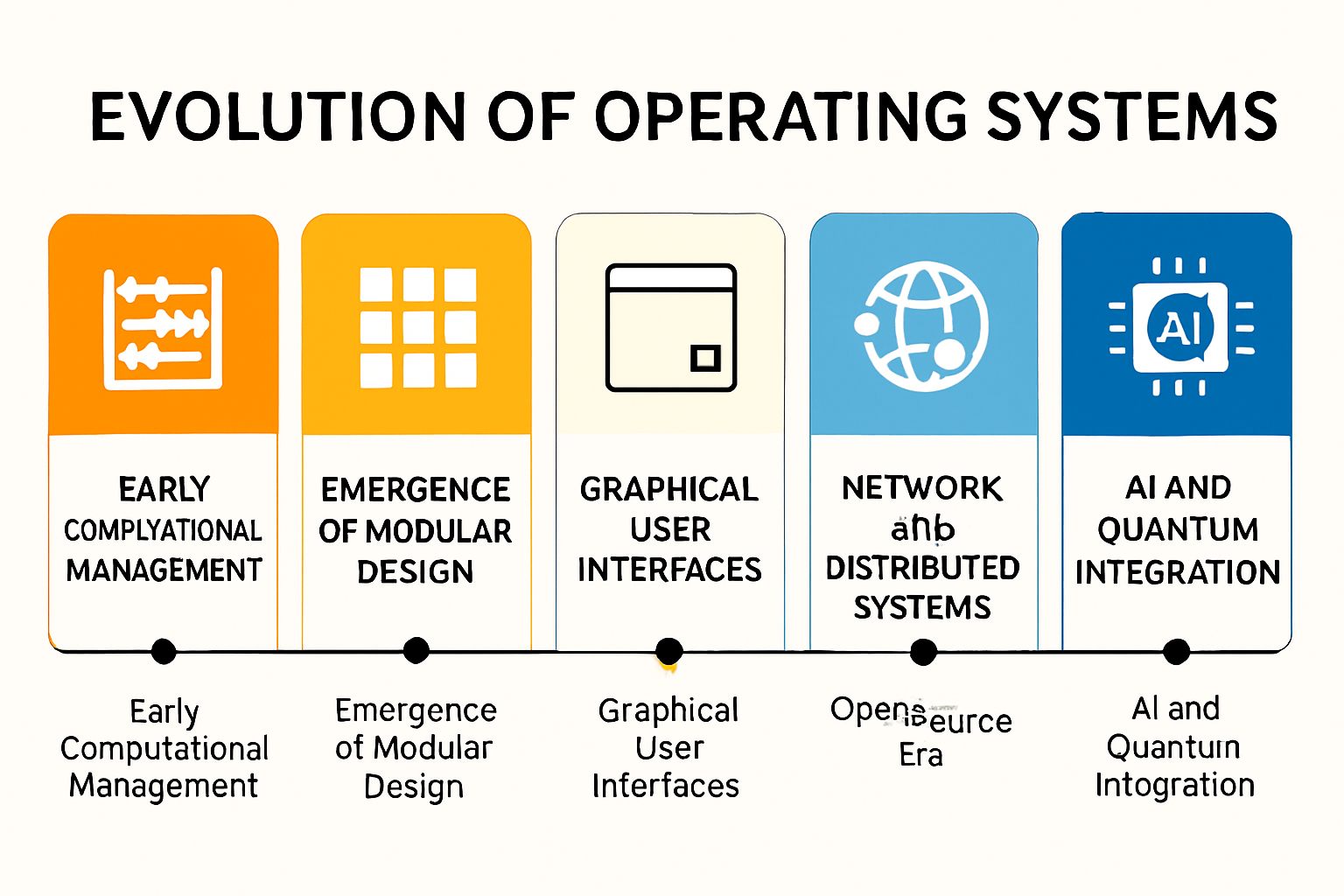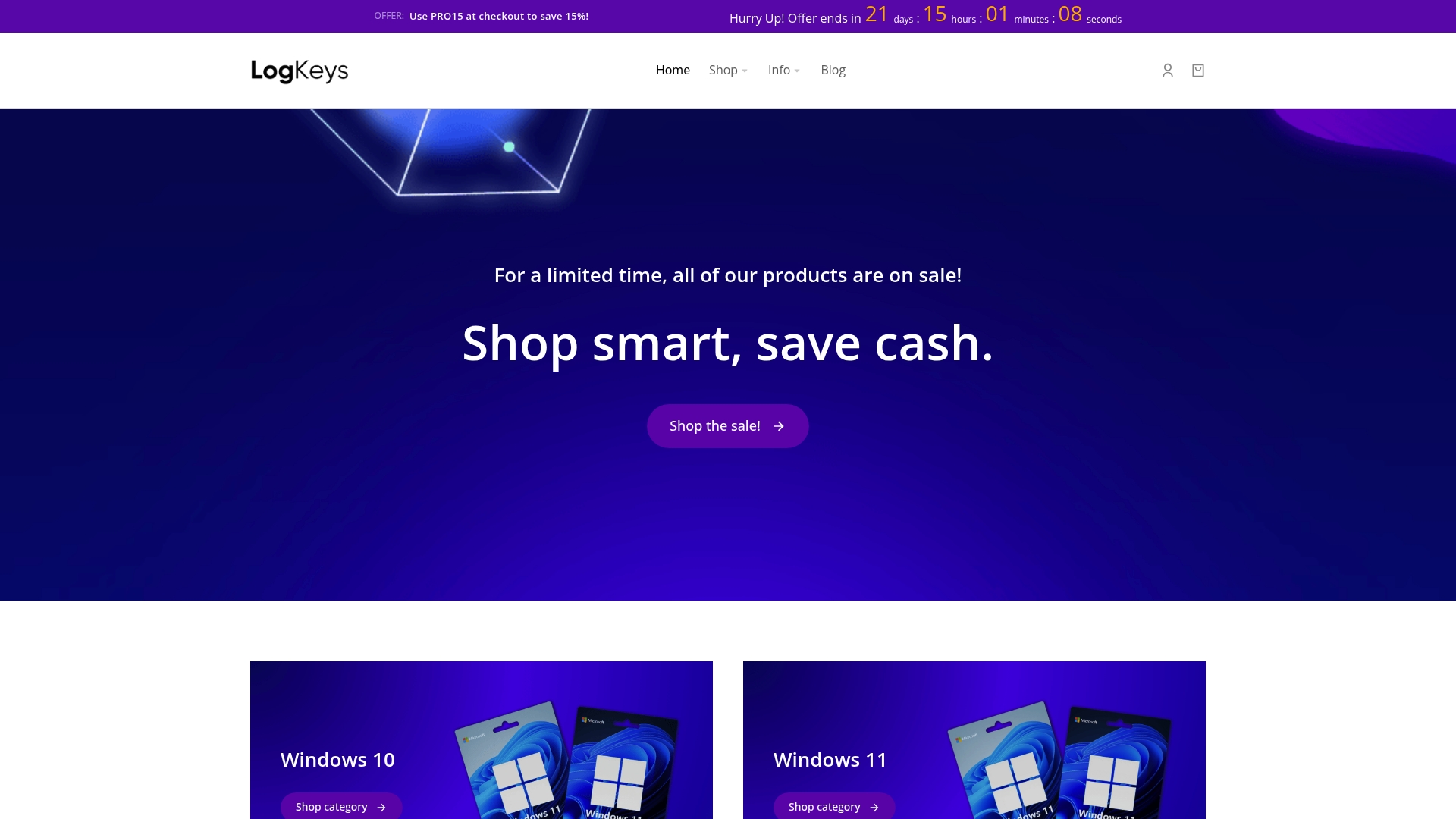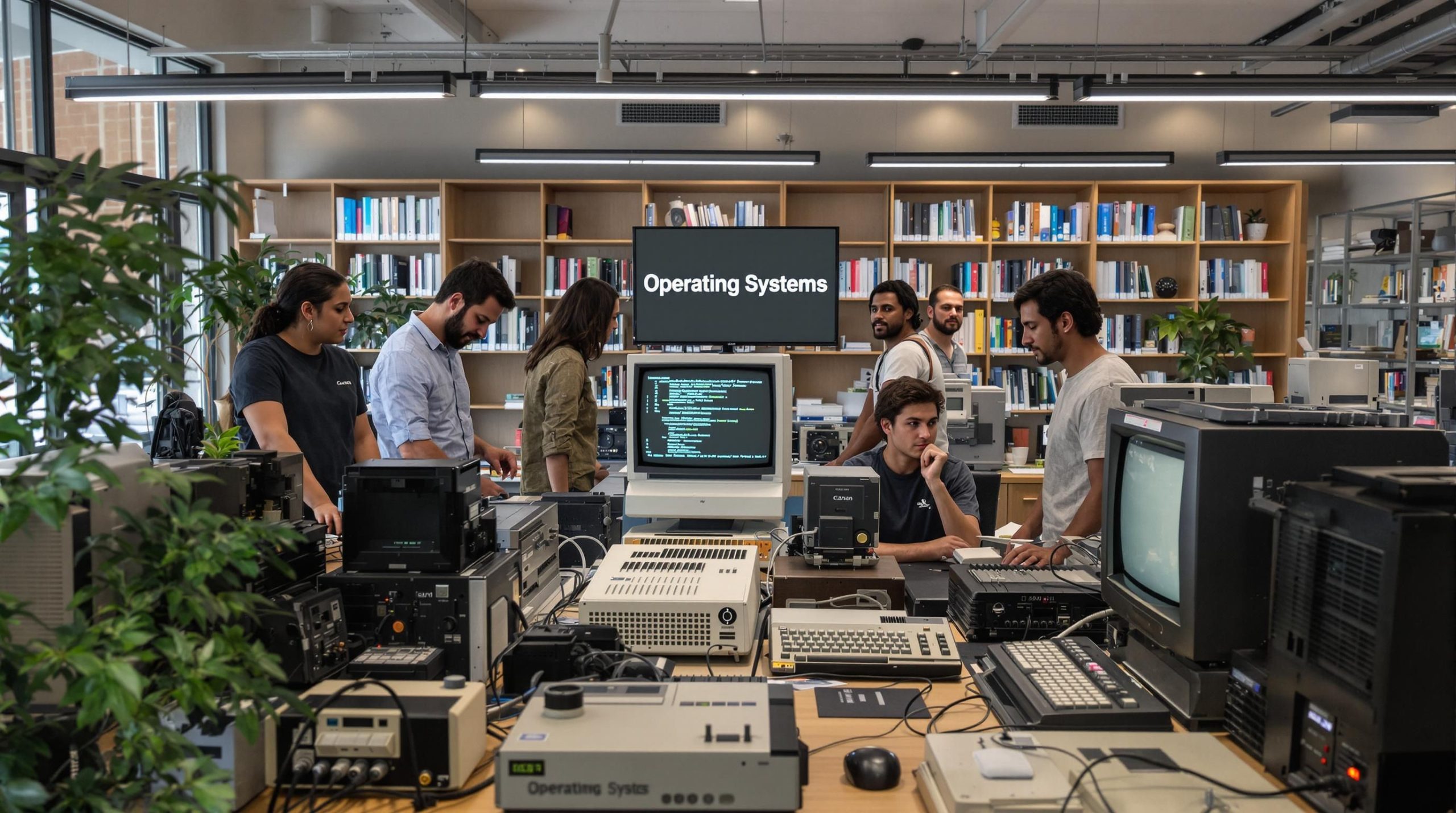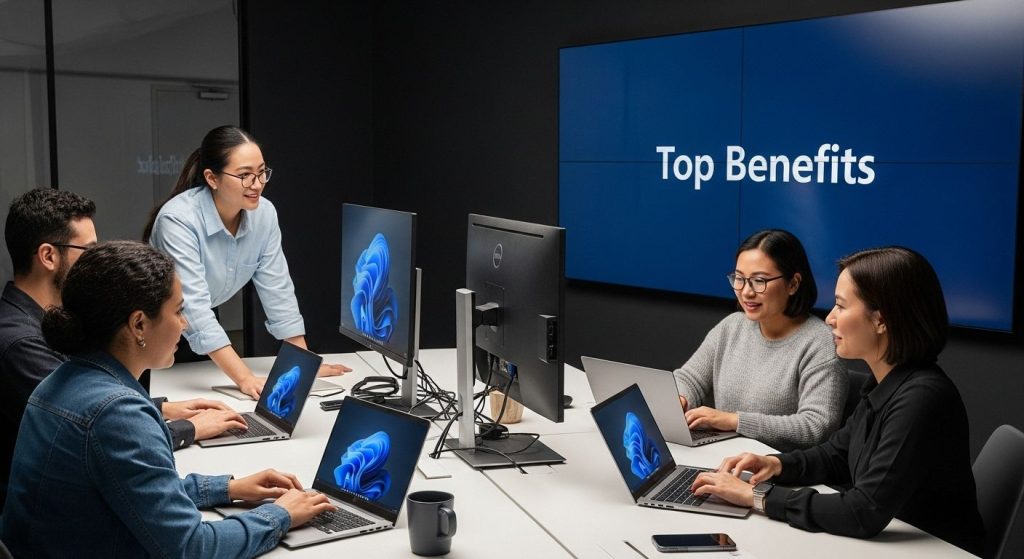The story of operating systems is packed with breakthroughs that shaped the way we use computers every day. Think about this. Unix, launched in 1969, introduced the world to modular software design and changed everything about how systems communicate. Most people expect the biggest influence came from powerful hardware or flashy new gadgets. Yet the most profound shifts actually started with simple code innovations that made computers smarter, faster, and far more accessible than anyone thought possible.
Table of Contents
ToggleQuick Summary
| Takeaway | Explanation |
|---|---|
| Operating systems have evolved significantly since the 1950s. | From basic job management to complex platforms, history of operating systems have transformed human-computer interaction over decades. |
| Unix revolutionized OS design with modularity. | It introduced the idea of building systems from interchangeable components, influencing countless software engineering practices. |
| Graphical User Interfaces changed user interactions. | The introduction of GUIs allowed users to engage with computers more intuitively, moving away from text-based commands. |
| Linux has democratized technology access globally. | Its open-source nature enables users in developing regions to access computing resources economically, bridging the digital divide. |
| Future OS design will incorporate AI and quantum computing. | Upcoming trends indicate history of operating systems will integrate intelligent features and advanced security mechanisms to enhance user experience. |
Early Development of Operating Systems
The history of operating systems represents a fascinating journey of technological innovation that transformed computing from complex mathematical machines to powerful interactive platforms. In the earliest days of computing, computers operated without sophisticated software interfaces, requiring engineers to manually input instructions and manage every computational task.
The Birth of Computational Management
The first significant breakthrough in operating system development emerged in the mid 1950s. The General Motors-NAA I/O operating system, developed in 1956 for the IBM 704, marked a pivotal moment in computing history. This groundbreaking system automated job handling processes, representing one of the first formal attempts to create software that could manage computer resources more efficiently.
By the early 1960s, computer scientists recognized the need for more advanced systems that could handle multiple tasks simultaneously. Research from MIT revealed that interactive computing and multiprogramming were becoming critical requirements for modern computational environments.

Pioneering Architectural Concepts
The Multics project, developed in the mid 1960s, introduced revolutionary concepts that would shape future operating system design. This innovative system introduced the groundbreaking concept of a single level memory architecture, allowing programs to reference data as if it were already in memory. This approach simplified data management and provided a more intuitive programming experience.
Key architectural innovations during this period included:
- Hierarchical File Systems: Organizing data in structured, nested directories
- Interactive Computing: Enabling direct user engagement with computer systems
- Multiprogramming Capabilities: Running multiple programs concurrently
To summarize, here’s a table outlining the key architectural innovations and their purposes during the early development era:
| Innovation | Purpose |
|---|---|
| Hierarchical File Systems | Organize data using structured, nested directories |
| Interactive Computing | Enable direct user engagement with computer systems |
| Multiprogramming Capabilities | Run multiple programs concurrently |
| Single Level Memory Architecture | Simplify data management and programming experience |
Technological Foundations
The early operating systems laid critical groundwork for modern computing. Systems like IBM’s System/360 further advanced the field by standardizing hardware interfaces and creating more robust software management techniques. These developments transformed computers from specialized research tools into versatile machines capable of handling complex computational tasks across various domains.
Engineers and computer scientists during this era were essentially building the digital infrastructure that would support decades of technological advancement. Their work represented not just technical innovation but a fundamental reimagining of how humans could interact with computational technology.
By the late 1960s, history of operating systems had evolved from simple job management tools to sophisticated platforms that could manage memory, process user commands, and provide a stable interface between hardware and software. This transformation set the stage for the personal computing revolution that would follow in subsequent decades.
Major Milestones in OS Evolution
The evolution of history of operating systems represents a remarkable journey of technological innovation, marked by groundbreaking developments that transformed computing from specialized research tools to ubiquitous platforms powering global technology infrastructure.
The Unix Revolution
The Unix operating system, developed in 1969 at Bell Labs by Ken Thompson and Dennis Ritchie, emerged as a pivotal milestone in operating system history. This revolutionary system introduced fundamental concepts that would shape computing for decades. Unix pioneered the idea of modular design, where complex systems could be built from simple, interchangeable components that could communicate through well-defined interfaces.
Unix’s design philosophy of creating small, specialized tools that could be combined to solve complex problems became a foundational principle in software engineering. Its portability and robust architecture allowed it to run on multiple hardware platforms, a radical concept at the time.
Graphical User Interface Emergence
The development of graphical user interfaces (GUIs) marked another critical milestone in operating system evolution. According to the timeline of operating systems, the 1980s saw dramatic transformations in how users interacted with computers. Xerox PARC’s Alto system first demonstrated the potential of GUI concepts, which were later refined by Apple with the Macintosh and Microsoft with Windows.
Key developments during this era included:
- Point and Click Interaction: Replacing text-based command lines
- Visual File Management: Using icons and windows to represent system resources
- Integrated Graphical Applications: Enabling more intuitive software design
Networked and Distributed Systems
By the late 1980s and early 1990s, operating systems began evolving to support networked and distributed computing environments. The 25th ACM Symposium on Operating Systems Principles (SOSP) highlighted how operating systems transitioned from standalone computational platforms to interconnected systems capable of complex distributed processing.
This era saw the rise of network-aware operating systems that could manage resources across multiple machines, support remote computing, and provide robust security mechanisms. Linux, developed by Linus Torvalds in 1991, emerged as an open-source alternative that would become fundamental to server infrastructure and later mobile computing platforms.
The progression of operating systems reflects not just technological advancement but a broader narrative of human-computer interaction. Each milestone represented a step towards making computational power more accessible, intuitive, and integrated into everyday life. From the complex manual systems of the 1950s to the sophisticated, networked environments of the 1990s, operating systems evolved from mere management tools to complex ecosystems that define how we interact with technology.
By the turn of the millennium, operating systems had become sophisticated platforms supporting global communication, complex computational tasks, and increasingly personalized user experiences. The journey from early batch processing systems to modern cloud-enabled operating systems demonstrates the incredible pace of technological innovation.
To provide a clear overview, the following table summarizes the major milestones in operating system evolution discussed above:
| Era/Innovation | Key Advancements | Impact |
|---|---|---|
| Unix Revolution (1969) | Modular design, portability | Influenced modern OS architecture |
| Graphical User Interfaces (1980s) | Visual interface, point-and-click, icons | Enhanced user interaction & accessibility |
| Networked/Distributed Systems (1990s) | Networking, distributed resource management, Linux | Enabled global connectivity & open-source |
Impact on Computing Across the World
Operating systems have profoundly transformed global computing, serving as the critical infrastructure that enables technological connectivity, economic development, and cross-cultural communication across diverse technological landscapes.
Global Technological Democratization
According to the OpenStax textbook on Information Systems, operating systems have played a pivotal role in democratizing technological access worldwide. By providing standardized interfaces and reducing technical complexity, these systems have enabled individuals and organizations in developing regions to leverage advanced computational capabilities.
In regions with limited technological infrastructure, open-source operating systems like Linux have been particularly transformative. These systems offer cost-effective solutions that can run on older hardware, making computing more accessible in economically constrained environments. Countries across Africa, Asia, and South America have increasingly adopted such technologies to bridge digital divides and support educational and economic development initiatives.
Economic and Organizational Transformation
Operating systems have become fundamental drivers of global economic productivity. They enable complex business processes, support international communication networks, and provide platforms for innovative digital services. Multinational corporations rely on sophisticated operating systems to manage distributed workforces, synchronize global operations, and maintain seamless communication across different geographical regions.
Key economic impacts include:
- Standardized Communication Protocols: Enabling real-time global collaboration
- Cloud Computing Infrastructure: Supporting scalable and flexible business models
- Cross-Platform Compatibility: Facilitating international technology integration
Cultural and Social Connectivity
Beyond economic realms, operating systems have dramatically reshaped social interactions and cultural exchanges. Mobile operating systems like Android and iOS have connected billions of people worldwide, transcending geographical boundaries and creating unprecedented opportunities for communication and information sharing.
In educational contexts, operating systems have enabled remote learning platforms, allowing students from diverse global backgrounds to access educational resources. They have supported translation technologies, collaborative research environments, and platforms that facilitate cross-cultural understanding.
The universality of modern operating systems represents more than mere technological achievement. These systems embody a global technological language that bridges cultural differences, supports international collaboration, and creates shared digital experiences across diverse human communities.
As technology continues to evolve, operating systems will remain critical in shaping how societies interact, innovate, and progress. Their impact extends far beyond computational mechanics, representing powerful tools for global connection, understanding, and collective human advancement.
Future Trends in Operating Systems 2025
The landscape of operating systems is rapidly evolving, driven by emerging technologies that promise to revolutionize how we interact with computational platforms. As we approach 2025, several transformative trends are set to reshape the fundamental architecture of operating systems.
Artificial Intelligence Integration
According to Gartner’s strategic technology trends, artificial intelligence is poised to become a core component of operating system design. The future of operating systems will not merely involve AI as a supplementary feature but as an integral, autonomous system capable of intelligent decision-making and proactive resource management. Research from advanced computational studies suggests that AI will fundamentally transform operating system functionalities. These intelligent systems will be capable of:
- Predictive Resource Allocation: Anticipating and managing computational resources in real-time
- Autonomous Security Protocols: Detecting and mitigating potential cybersecurity threats automatically
- Personalized User Experience: Adapting system interfaces and performance based on individual user behaviors
Quantum Computing and Security Paradigms
Quantum computing represents another critical frontier in operating system development. The emergence of post-quantum cryptography addresses the potential vulnerabilities introduced by advanced quantum technologies. Operating systems in 2025 will increasingly incorporate quantum-resistant security mechanisms to protect against sophisticated computational threats.
This evolution requires rethinking traditional security architectures. Quantum-aware history of operating systems will need to develop complex encryption protocols that can withstand potential quantum decryption attempts. Readers interested in exploring Windows 10 security features can find more details about modern operating system protections.
Distributed and Edge Computing Environments
The proliferation of Internet of Things (IoT) devices and edge computing infrastructures will demand more sophisticated, lightweight history of operating systems. These next-generation platforms must efficiently manage distributed computational resources across diverse hardware ecosystems, from smartphones to industrial sensors.
Key characteristics of future history of operating systems will include:
- Minimal Resource Footprint: Efficient performance on diverse hardware configurations
- Seamless Interoperability: Smooth communication between different device types and platforms
- Dynamic Scalability: Ability to adapt to changing computational requirements
The trajectory of operating systems reflects a broader technological narrative. We are moving from rigid, monolithic systems to intelligent, adaptive platforms that can understand, predict, and respond to user needs with unprecedented sophistication.
By 2025, operating systems will no longer be mere software interfaces but intelligent ecosystems that bridge human intention with computational capabilities. The convergence of AI, quantum computing, and distributed technologies promises a future where computational platforms are more intuitive, secure, and responsive than ever before.

Frequently Asked Questions
What is the significance of Unix in the history of operating systems?
Unix, launched in 1969, introduced modular software design, allowing for interchangeable components, which has significantly influenced operating system architecture and software engineering practices.
How did graphical user interfaces (GUIs) change user interaction with computers?
The introduction of GUIs in the 1980s transformed user interaction by replacing complex text-based commands with point-and-click interfaces, making computers more accessible to the general public.
What role do history of operating systems play in global technology access?
Operating systems, particularly open-source options like Linux, have democratized technology access, enabling users in developing regions to utilize sophisticated computing resources without high costs.
What trends are expected in history of operating systems by 2025?
By 2025, operating systems are expected to integrate artificial intelligence for predictive resource management, adopt quantum computing security measures, and support distributed and edge computing environments for enhanced efficiency.
Experience the Next Evolution of Operating Systems With Genuine Software
Looking back at the history of operating systems, one core challenge stands out: ensuring seamless access, security, and performance as technology rapidly advances. The article explored the transformation from early Unix modularity to modern AI and quantum-ready platforms, and highlighted a major pain point—keeping your PC protected and fully activated as history of operating systems become increasingly complex. Many users today still struggle with expired or unreliable licenses, leaving their systems vulnerable and their experience disrupted.

Stay ahead by securing authentic Microsoft licenses for Windows 10 or Windows 11 from a trusted provider. Visit Logkeys.com to shop official product keys backed by 24/7 support, fast delivery, and affordable prices. Unlock every feature your operating system was designed to deliver. Avoid interruptions and enjoy hassle-free activation—take the leap today with Logkeys.com for genuine, secure, and future-proof solutions.
Recommended
- Windows 11 for Students: Top Features and Study Benefits 2025
- Windows 10 For PC Install & Download Windows 10 For PC – LogKeys
- Windows 10 For PC Install & Download Windows 10 For PC – LogKeys
- Windows 10 For PC Install & Download Windows 10 For PC – LogKeys
- Web Development Basics 2025: Guide for Modern Businesses
- What Is HPC? Guide for AI, Data Centers & Enterprises (2025) – Blockware Solutions











